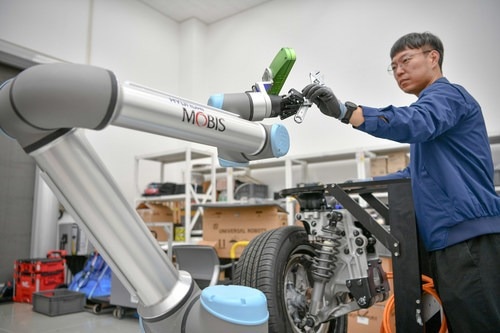Reviewed by Aimee MolineuxNov 29 2022
Hyundai Mobis, an innovator in futuristic solutions for the smart mobility industry, launched a range of robots that can be employed at general manufacturing units or in smart factories.

Collaborative robots developed by Hyundai Mobis. Image Credit: Hyundai Mobis.
The robots will comprise a set of technologies that boost safe interactions between robots and their human colleagues. With its growth into the robotics sector, Hyundai Mobis is again reinforcing its place as a leader in crucial future vehicle technologies, including autonomous driving and electrification.
Recently, Hyundai Mobis announced that it had finished the development of mobile collaborative robotic and logistics robotic systems established on autonomous driving, which has been applied in a pilot operation in its Ulsan site.
The novel robotic systems can be employed in manufacturing or distribution bases and service locations. Hyundai Mobis has also successfully built a dedicated integrated controller and control system, which is vital for delivering robotic solutions.
The mobile robots equipped with articulated arms can move autonomously in diverse settings, such as offices or factories, carrying out jobs in partnership with the persons in charge. Mobile collaborative robots are fitted with LiDAR sensors and cameras, enabling them to travel in different directions, such as to and fro or sideways.
The most noticeable characteristic of these robots is that they can provide mobile services. In contrast to wearable or general industrial robots, mobile collaborative robots serve different purposes in residential and commercial spaces.
The robots’ vision cameras and moving arms enable them to carry out interactive functions with their human colleagues, such as organizing products on the shelf or delivering hot coffee from the barista to a table.
The self-driving logistic robots, also designed by Hyundai Mobis, are low-floor robots that travel autonomously from production lines to distribution warehouses conveying goods or supplies. The 152 mm-tall robots can move up to 200 kg with the capacity to lift to a height of 12 cm.
These robots with the fitted LiDARs and camera and ultrasonic wave-enabled sensors can identify their locations at the site as well as the locations of delivering materials via ideal paths that have been predetermined to avoid impediments and workers.
Furthermore, Hyundai Mobis secured a system that enables in-built control of many self-driving logistics robots within a single workplace. The main feature of this control system is stopping crashes and deadlocks between robots. Hyundai Mobis designed and applied an exclusive algorithm that envisages and regulates in real-time the movement of many robots.
Hyundai Mobis is also engineering a robotics platform that can be employed outdoors. The system will be integrated with the robo-wheel technology, which has been built to aid the robots in moving safely in outdoor settings, such as bumpy road surfaces and slopes. The integrated control algorithm of the robo-wheel will enable different driving motions, including sideways crab driving and a 360-degree zero turn.
We are brainstorming innovative and creative ideas to develop safe and precise robotics technologies. We hope to use these human-robot collaborative solutions to further expand the scope of our business.
Lee Seung-Hwan, Head of Advanced Engineering, Hyundai Mobis
Hyundai Mobis is also planning to create several robot platforms established on the fundamental technologies of the mobile collaborative robots and self-driving logistics robots that are presently in the development stage. The project will concentrate on progressing robot driving, human-robot interface, and robot control technologies, which will be employed in various areas, such as offices, distribution bases, smart factories, and households.
In March 2022, Hyundai Mobis added robotics and UAM to its business group to acquire long-term growth engines, concurrently announcing its aim to scale the business model to include next-generation growth areas.